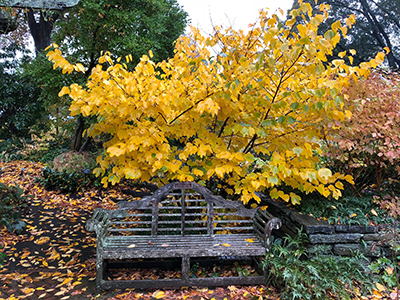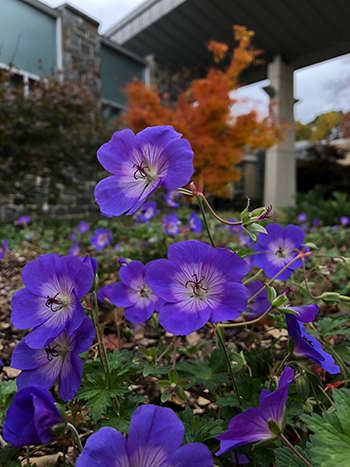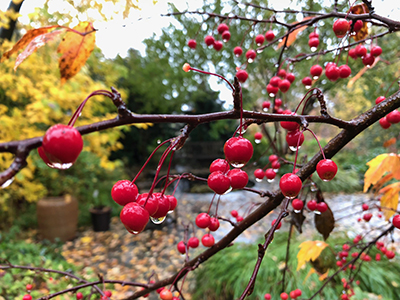
Plants of the Week: November 5

Lindera obtusiloba bears many similarities to its North American relative, Lindera benzoin. Both produce small, greenish-yellow flowers in early spring on dioecious plants (separate male and female plants) and possess fragrant stems, a quality that lends protection from deer browse. Characteristics unique to the species include a vase-shape habit, think Hamamelis x intermedia, and fun, variable leaf shape.
Much like sassafras, Lindera obtusiloba produces unlobed, simple leaves as well as leaves with one (mitten-shaped) to two lobes (trident-shaped) all on the same plant. Consistent, brilliant yellow fall color persists for up to two weeks. A specimen can be seen in the Terry Shane Teaching Garden. Photo credit: J. Coceano
 Geranium ‘Gerwat’, more commonly known in the trade as Geranium Rozanne®, is a patented hybrid clump-forming herbaceous geranium. It is noted for its almost non-stop flowering throughout the growing season, and exceptional heat tolerance. The initial spring flush of blooms begins in late spring and carries through until October. The genus name is derived from the Greek word geranos, meaning crane, a reference to the fruit resembling the neck and head of the bird. This reference also contributes to the common name of hardy cranesbill. A planting featuring this hardy geranium cultivar anchors a new bed at the Science Center. Photo credit: J. Coceano
Geranium ‘Gerwat’, more commonly known in the trade as Geranium Rozanne®, is a patented hybrid clump-forming herbaceous geranium. It is noted for its almost non-stop flowering throughout the growing season, and exceptional heat tolerance. The initial spring flush of blooms begins in late spring and carries through until October. The genus name is derived from the Greek word geranos, meaning crane, a reference to the fruit resembling the neck and head of the bird. This reference also contributes to the common name of hardy cranesbill. A planting featuring this hardy geranium cultivar anchors a new bed at the Science Center. Photo credit: J. Coceano

The Missouri Botanical Garden, a tried and true reference, succinctly sums up the many positive attributes of Malus ‘JFS-KW5’ Royal Raindrops: “Royal Raindrops, is an upright-spreading, disease-resistant, easy-to-grow, crabapple tree that features: (1) deeply lobed purple foliage (early leaves may be entire) which retains excellent color throughout summer, (2) magenta-pink single flowers in spring (April in St. Louis), (3) tiny maroon-red crabapples (1/4″ diameter) that mature in late summer and (4) excellent orange-red fall color.
This small tree typically matures to 15-20’ tall and to 12-16′ wide with a dense rounded canopy and excellent foliage density.” I am especially keen on its disease-resistance and fruit set. Birds, most noticeably robins, relish the fruit, particularly after a frost has sweetened them. Photo credit: J. Coceano





No Comments